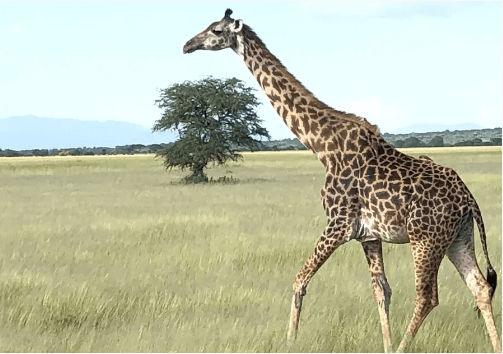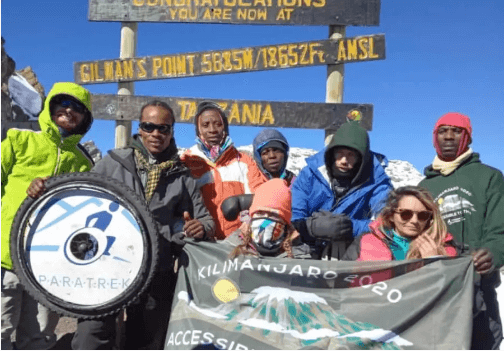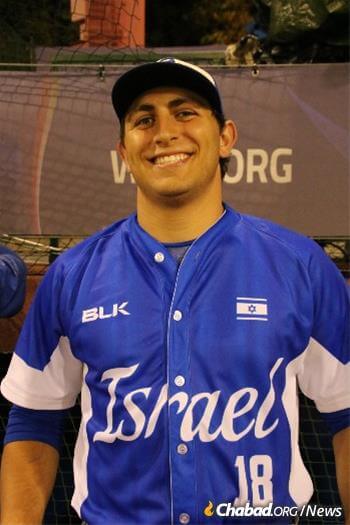Original Article Published On The Jerusalem Post
“Climbing a mountain is more about the mind. If you take it easy and relax, all goes easy,” said Sabino (“Sabi”) Kweka.
Marcella Maranon approaches the immigration booth at Kilimanjaro International Airport in Tanzania, hands her passport to the agent, looks up from her wheelchair and exclaims, “I did it. I climbed Kilimanjaro!” He and his fellow agents are respectful yet seem a bit surprised, as Maranon produces photos on her iPhone to prove it.
“There were four of us – in a special chair,” reports Maranon, explaining that four of the 27 climbers had paraplegia and other disabilities. “Were there any Tanzanians?” the agent asks. “Yes, Arnold lives in Moshi at the bottom of the mountain!” Arnold John, a father of three, lives at the base of Kilimanjaro and had always dreamed of making it to the top.
Maranon’s enthusiasm and determination are infectious. Dressed in her signature “The Journey of a Brave Woman” jeans jacket, she travels the world alone, sharing her experiences with accessibility on social media – and with anybody willing to hear her amazing story.
Maranon and John represent two of the 27 hikers with different abilities who recently climbed the 19,341-foot mountain to benefit Friends of Access Israel (FAISR), an organization promoting accessibility, inclusion and respect for people of all abilities around the world. FAISR’s collaborative partner, Access Israel, was founded just over 20 years ago in Israel and hosts an international conference each year in Israel, hosts “dinners of the senses,” and consults on accessibility and inclusion worldwide.
The FAISR Kilimanjaro 2020 Team included hikers from Texas, Montana, New York and New Jersey in the United States, as well as participants from Israel. Other hikers with physical disabilities who participated on the strenuous, multi-day, heavily supported climb included Starla Hilliard-Barnes of Utah, a twice-paralyzed participant, and Arnon Amit, paralyzed in a car accident during his IDF army service.
Preparing for the climb
The American delegation arrived in Tanzania with a wide range of gear, including hiking boots, poles and appropriate clothing to assure comfort as they passed through five ecosystems. The Israeli delegation, consisting of Arnon, Omer Zur and Rowee Benbenishty, had a more extensive packing list; they were charged with boxing, transporting and assembling five Paratreks (“Trekkers”) – specially designed chairs that, with the help of Tanzanian porters, would help get the participants with disabilities up the mountain.
Zur is the inventor and CEO of Paratrek, a large-tire wheelchair-like device that relies on the abilities of both the rider and a team of up to six who pull, push and steer to make it possible for people with disabilities to join peers in such treks. Zur designed the initial Paratrek for his own father. Three years into his post-army trek, Omer realized that his father never had this opportunity for a post-army trip, as he was paralyzed in the in the Sinai Desert during the Yom Kippur War when he was thrown from a tank. Omer invited his dad to travel with him in the mountains of Turkey for a month, but needed a way to accommodate his mobility needs. They designed and subsequently refined the Paratrek. Zur, a licensed tour guide, father of four and resident of Hannaton, and colleague, Rowee Benbenishty, skillfully packed up four Paratreks, tools and replacement parts, which they skillfully maintained throughout the Kilimanjaro climb.The delegation assembled at a hotel in Moshi, Tanzania at the base of the mountain for a specially prepared kosher dinner, evening prayers and orientation. The group met Sabino (“Sabi”) Kweka, a former porter and guide, who is now owner of the Popote Africa Adventures and the trip architect and coordinator.
“Climbing a mountain is more about the mind. If you take it easy and relax, all goes easy,” Sabi noted. He explained that the group would follow the Marangu route, also known as the Coca Cola trail. We would stay overnight at the Mandara Hut (2,700 meters), Horombo Hut 3,700 meters), and spend Shabbat at the Kibo Hut (4,700 meters). Following a restful Shabbat on the mountain, we would attempt the all-night climb to the 5,895-meter Uhuru Peak. Kweka has guided several Israeli groups in the past, including groups who were kosher and Sabbath observant. Veteran guide, Shani Mrema, observes, “Israelis are very fast,” usually preferring to reach the summit in four days over the recommended six days.
In accordance with best practices and Tanzanian law, which assures the safety of hikers with and without disabilities, the delegation would be accompanied by three cooks, 11 guides and 70 porters. Porters carry all participant clothing and sleeping bags as well as food, water and cooking supplies. Cooks provided kosher meals both at the huts and along the route. Daily mileage up the dormant volcano would range from 3.1 miles on the acclimation days, to 13.7 miles during the final midnight to sunrise ascent to the summit.Each year, approximately 35,000 people attempt to climb Kilimanjaro. They use the six official Kilimanjaro routes. The chances of reaching the summit of Kilimanjaro is highly dependent on the number of days taken to trek the mountain. The more days devoted to the climb, the higher the probability of success, as the body has more time to adapt and acclimatize. According to success rate figures published by the Kilimanjaro National Park, there is a 45% success rate for reaching the summit with chances of success rising to 85% if done over an eight-day period. Between three and seven people reportedly die on Kilimanjaro each year.



As the group set out from the Marangu Gate on February 4, John, the Tanzanian climber, was surrounded by Tanzanian media interviewing him for TV and newspapers; they wanted to hear the story of the local man who grew up at the base of the mountain, now having his first opportunity – with the support of the Israeli-designed Paratrek – to climb the mountain. At the same time, hikers were filling water bottles, checking emails and making calls for the last time in 10 days, and porters were receiving their orientation on how to “drive” and operate the four Trekkers.It quickly became clear that the multi-day climb ahead would be very challenging for climbers with and without disabilities. Navigating steep ascents, boulders, streams and more would require extreme effort by all and additional support for the porters assisting the Trekkers. Six porters would be needed to assure the safety of the trekkers and to reduce risk of burnout of the otherwise indefatigable porters. An additional 10 guides were soon added to the delegation. Hot meals at the end of each day – and very tasty local avocados and mangos – provided somewhat of a morale boost, though lack of showers, sitting toilets, cell/Wi-Fi access and very cold nights were ongoing sources of frustrations.
Yet the group pulled together throughout. Even during moments of frustration and low morale, group members encouraged and inspired each other. When the group was brainstorming needed tweaks, Shannon Barnes of Kalispell, Montana, husband of twice-paralyzed participant, Starla, reported, “I just want to say that Starla had a great day and has no complaints.” The group continued on.After four days of hiking, the group celebrated Shabbat together at the 4,700 meter Kibo hut. Dr. Barry Stein of Manhattan led Kabbalat Shabbat prayers in the dining room in a subdued voice out of respect to fellow dorm mates from other groups, catching some sleep before their Friday 11 p.m. ascent. Mara Lassner, wife of James Lassner, executive director of Friends of Access Israel, brought grape juice and several challah rolls for the group’s Shabbat dinner.Shabbat on the mountain was relaxing, though it offered several logistical challenges for the fully Sabbath observant. In the absence of an eruv, there were questions of how to bring toilet paper to a dark bathroom. While most carried water and poles on the Saturday afternoon, acclimatization hike, some opted out due to leaving t’chum Shabbat (Sabbath boundaries), and others were comfortable with a compromise – walking without hiking poles as porters carried water.
Dr. Aaron Gindea, a New York cardiologist, was excited to read the Torah portion of Beshalach at 4,700 meters, an elevation he believes to be the highest where the torah was ever read. Fellow hiker, David Icikson, president of Gindea’s Manhattan Orthodox Synagogue, Orach Chaim, was pleased that the Torah he carefully and respectfully transported throughout the trip was read on Shabbat morning and afternoon, Mondays and Thursdays of the trek. In order to assure a minyan of men, at least one of the secular Israelis had to agree to participate in each prayer service – no small task, given the amount of time they needed to dedicate to assuring proper daily maintenance of the Paratreks. On Shabbat morning, the Torah was carried down many stairs so Arnon could recite the Torah blessings from his wheelchair.
Following Shabbat lunch, hiker Joseph Grunfeld, who experienced a traumatic knee injury to both knees three years ago, delivered a moving d’var Torah (sermon) about crossing seas and climbing mountains. Each participant then shared reasons for participating on the hike. Dr. David Muller of Teaneck, New Jersey, dean for medical education at the Mount Sinai School of Medicine in New York, observed that the participants – fully dependent on our Tanzanian porters, guides and cooks for food and water – experienced a small taste of what it must be like for our fellow trekkers with disabilities who daily rely on others for various aspects of care and support.The all-night climb to the summit Following an early dinner and a four-hour late Saturday evening nap, the group assembled, wearing three layers on their legs, at least five layers on top and with gloves, hats, head lamps and warm drinking water so as to delay the time before water would freeze on the mountain. The group trekked in the dark, through elevated deserts and snowy terrain for approximately nine hours. Some experienced rapid heartbeat, tiredness and nausea. The trekkers and porters continued their ascent. Hiker Amy Verschleiser’s guide reported that the summit was the second windiest he had ever seen the summit in his 300 climbs! Thankfully, each participant – with and without disabilities – reached one of the three summits: Stella’s Point (5,756 meters), Gilman’s Point (5,685 meters), or Uhuru Peak (5,995 meters).
James Lassner, executive director of Friends of Access Israel, and the creative mind behind the Kilimanjaro expedition, notes, “Every day, people with disabilities face many personal ‘mountains to climb,’ some visible, but most hidden. They are no different than anyone else, as they have the same dreams, desires, hopes and aspirations, including ‘bucket list items.’ We at Friends of Access Israel are so proud of the accomplishment of all of the individuals that joined us to make up our diverse FAISR Kilimanjaro Family. United together, they used their collective physical strengths, mental toughness, diverse abilities, musical/dancing talents and humor to make each inch of Kilimanjaro accessible together!”

Karen Tamley, who recently left her position with the Chicago Mayor’s Office for People with Disabilities (MOPD) Commissioner and now serves as president and CEO of Access Living, presented at the May, 2019 Access Israel conference. She is similarly proud of what the group accomplished and what the trek represents.
“Growing up as a wheelchair user, I sat on the sidelines and was never able to participate in sports or recreation with my peers. This trip, which includes climbers both with and without disabilities, shows me how our society is becoming more inclusive and accessible for people with disabilities. This trip represents the pushing of the boundaries toward a more inclusive world where hikers/climbers with and without disabilities can meet this meet this incredible challenge together. This trip represents the ways in our world can become a more accessible for everyone in all aspects of life.”

The celebratory safari – and meeting the Jewish community of ArushaThe group purchased soft drinks and souvenirs at the base of the mountain, ate lunch and drove quickly to the hotel in Moshi for hot showers, boot cleaning and Wi-Fi access. Everyone enjoyed a celebratory dinner and received certificates of completion for reaching the summit.Most hikers elected to participate in safaris to both the Tarangire National Park, and the Ngorongoro Conservation Park. Highlights included seeing giraffes, elephants, zebras, flamingos, ostriches, gazelles and even lions in their natural habitat. Toyota Land Cruisers with roofs that open up to allow photography in four directions were the perfect vehicle for navigating the safari’s sometimes muddy terrain.
The Ngorongoro Coffee Lodge, accommodations for the group between safari days, offered large private rooms – each with two king-sized beds, a desk, large bathroom with a shower and tub, and porches. Views of the large pool, foliage and coffee trees were stunning.The final day in Tanzania was action-packed. A large group left the upscale Mt. Neru Hotel in Arusha early morning to meet the small Arusha Jewish community for morning prayer services. A synagogue in Otttawa, Canada recently donated a Torah scroll to this unique Jewish community whose members are descendants of Yemenite and Moroccan Jews who came to eastern Africa in the 1880s. We were warmly welcomed by community head, Yehuda Amir Kahalani, who is a local lawyer and college professor.
Following breakfast at the hotel, the group enjoyed the opportunity to visit Shanga Village, a vocational training program for people with disabilities, and to purchase colorful, hand-crafted souvenirs at Shanga, the Arusha Cultural Heritage Center and at the Maasai Market. A very tired, satisfied group then began to make its way to the Kilimanjaro International Airport for a 45-minute flight to Nairobi, Kenya and an additional 15-hour flight to JFK. The four trekkers from Kalispell, Montana and Maranon from Dallas had additional layovers and flights before arriving safely home. On the Kenya Airways flight from Nairobi to New York, the pilot, who somehow learned about the FAISR group, congratulated Marcela as the first Peruvian-born paralyzed woman to climb the famous mountain.
Parartrek’s founder, Omer Tzur, who had returned safely to Israel a few days earlier, had an opportunity to reflect on the Kilimanjaro experience.
“Ascending the peak of Kilimanjaro is a dream come true not because of the mountain. That was never a dream of mine. The dream that we fulfilled is to see this group, people with and without disabilities – and major ones – climbing up together, as a group, as people who see each other as equals. To see that, out there in a super non-accessible trail, for me, is a reason to continue doing what we do!”






